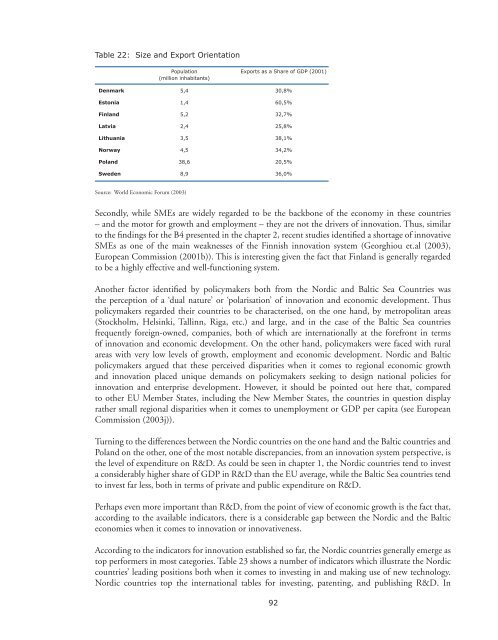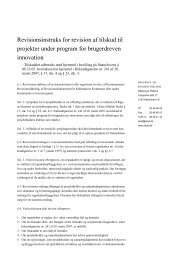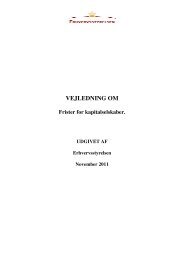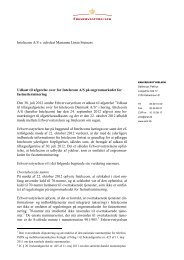Competing in the Single Market - SMEs and ... - Erhvervsstyrelsen
Competing in the Single Market - SMEs and ... - Erhvervsstyrelsen
Competing in the Single Market - SMEs and ... - Erhvervsstyrelsen
Create successful ePaper yourself
Turn your PDF publications into a flip-book with our unique Google optimized e-Paper software.
Table 22: Size <strong>and</strong> Export OrientationPopulation(million <strong>in</strong>habitants)Exports as a Share of GDP (2001)Denmark 5,4 30,8%Estonia 1,4 60,5%F<strong>in</strong>l<strong>and</strong> 5,2 32,7%Latvia 2,4 25,8%Lithuania 3,5 38,1%Norway 4,5 34,2%Pol<strong>and</strong> 38,6 20,5%Sweden 8,9 36,0%Source: World Economic Forum (2003)Secondly, while <strong>SMEs</strong> are widely regarded to be <strong>the</strong> backbone of <strong>the</strong> economy <strong>in</strong> <strong>the</strong>se countries– <strong>and</strong> <strong>the</strong> motor for growth <strong>and</strong> employment – <strong>the</strong>y are not <strong>the</strong> drivers of <strong>in</strong>novation. Thus, similarto <strong>the</strong> f<strong>in</strong>d<strong>in</strong>gs for <strong>the</strong> B4 presented <strong>in</strong> <strong>the</strong> chapter 2, recent studies identified a shortage of <strong>in</strong>novative<strong>SMEs</strong> as one of <strong>the</strong> ma<strong>in</strong> weaknesses of <strong>the</strong> F<strong>in</strong>nish <strong>in</strong>novation system (Georghiou et.al (2003),European Commission (2001b)). This is <strong>in</strong>terest<strong>in</strong>g given <strong>the</strong> fact that F<strong>in</strong>l<strong>and</strong> is generally regardedto be a highly effective <strong>and</strong> well-function<strong>in</strong>g system.Ano<strong>the</strong>r factor identified by policymakers both from <strong>the</strong> Nordic <strong>and</strong> Baltic Sea Countries was<strong>the</strong> perception of a ‘dual nature’ or ‘polarisation’ of <strong>in</strong>novation <strong>and</strong> economic development. Thuspolicymakers regarded <strong>the</strong>ir countries to be characterised, on <strong>the</strong> one h<strong>and</strong>, by metropolitan areas(Stockholm, Hels<strong>in</strong>ki, Tall<strong>in</strong>n, Riga, etc.) <strong>and</strong> large, <strong>and</strong> <strong>in</strong> <strong>the</strong> case of <strong>the</strong> Baltic Sea countriesfrequently foreign-owned, companies, both of which are <strong>in</strong>ternationally at <strong>the</strong> forefront <strong>in</strong> termsof <strong>in</strong>novation <strong>and</strong> economic development. On <strong>the</strong> o<strong>the</strong>r h<strong>and</strong>, policymakers were faced with ruralareas with very low levels of growth, employment <strong>and</strong> economic development. Nordic <strong>and</strong> Balticpolicymakers argued that <strong>the</strong>se perceived disparities when it comes to regional economic growth<strong>and</strong> <strong>in</strong>novation placed unique dem<strong>and</strong>s on policymakers seek<strong>in</strong>g to design national policies for<strong>in</strong>novation <strong>and</strong> enterprise development. However, it should be po<strong>in</strong>ted out here that, comparedto o<strong>the</strong>r EU Member States, <strong>in</strong>clud<strong>in</strong>g <strong>the</strong> New Member States, <strong>the</strong> countries <strong>in</strong> question displayra<strong>the</strong>r small regional disparities when it comes to unemployment or GDP per capita (see EuropeanCommission (2003j)).Turn<strong>in</strong>g to <strong>the</strong> differences between <strong>the</strong> Nordic countries on <strong>the</strong> one h<strong>and</strong> <strong>and</strong> <strong>the</strong> Baltic countries <strong>and</strong>Pol<strong>and</strong> on <strong>the</strong> o<strong>the</strong>r, one of <strong>the</strong> most notable discrepancies, from an <strong>in</strong>novation system perspective, is<strong>the</strong> level of expenditure on R&D. As could be seen <strong>in</strong> chapter 1, <strong>the</strong> Nordic countries tend to <strong>in</strong>vesta considerably higher share of GDP <strong>in</strong> R&D than <strong>the</strong> EU average, while <strong>the</strong> Baltic Sea countries tendto <strong>in</strong>vest far less, both <strong>in</strong> terms of private <strong>and</strong> public expenditure on R&D.Perhaps even more important than R&D, from <strong>the</strong> po<strong>in</strong>t of view of economic growth is <strong>the</strong> fact that,accord<strong>in</strong>g to <strong>the</strong> available <strong>in</strong>dicators, <strong>the</strong>re is a considerable gap between <strong>the</strong> Nordic <strong>and</strong> <strong>the</strong> Balticeconomies when it comes to <strong>in</strong>novation or <strong>in</strong>novativeness.Accord<strong>in</strong>g to <strong>the</strong> <strong>in</strong>dicators for <strong>in</strong>novation established so far, <strong>the</strong> Nordic countries generally emerge astop performers <strong>in</strong> most categories. Table 23 shows a number of <strong>in</strong>dicators which illustrate <strong>the</strong> Nordiccountries’ lead<strong>in</strong>g positions both when it comes to <strong>in</strong>vest<strong>in</strong>g <strong>in</strong> <strong>and</strong> mak<strong>in</strong>g use of new technology.Nordic countries top <strong>the</strong> <strong>in</strong>ternational tables for <strong>in</strong>vest<strong>in</strong>g, patent<strong>in</strong>g, <strong>and</strong> publish<strong>in</strong>g R&D. In92
















